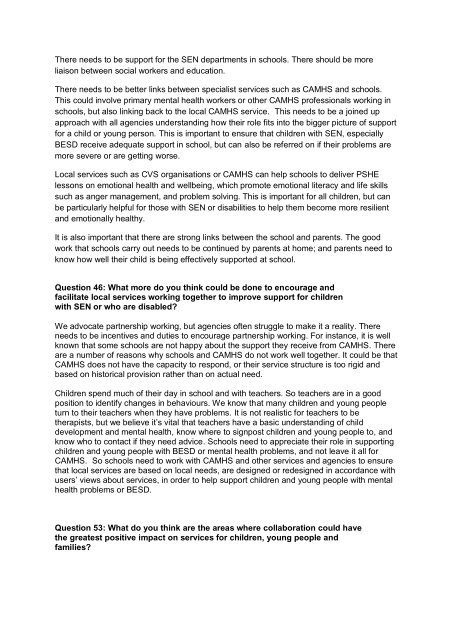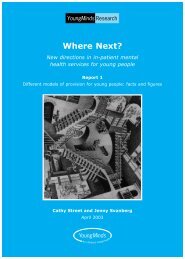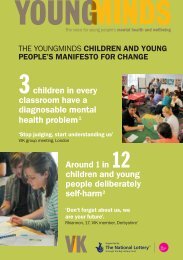Response to the SEN green paper - YoungMinds
Response to the SEN green paper - YoungMinds
Response to the SEN green paper - YoungMinds
Create successful ePaper yourself
Turn your PDF publications into a flip-book with our unique Google optimized e-Paper software.
There needs <strong>to</strong> be support for <strong>the</strong> <strong>SEN</strong> departments in schools. There should be moreliaison between social workers and education.There needs <strong>to</strong> be better links between specialist services such as CAMHS and schools.This could involve primary mental health workers or o<strong>the</strong>r CAMHS professionals working inschools, but also linking back <strong>to</strong> <strong>the</strong> local CAMHS service. This needs <strong>to</strong> be a joined upapproach with all agencies understanding how <strong>the</strong>ir role fits in<strong>to</strong> <strong>the</strong> bigger picture of supportfor a child or young person. This is important <strong>to</strong> ensure that children with <strong>SEN</strong>, especiallyBESD receive adequate support in school, but can also be referred on if <strong>the</strong>ir problems aremore severe or are getting worse.Local services such as CVS organisations or CAMHS can help schools <strong>to</strong> deliver PSHElessons on emotional health and wellbeing, which promote emotional literacy and life skillssuch as anger management, and problem solving. This is important for all children, but canbe particularly helpful for those with <strong>SEN</strong> or disabilities <strong>to</strong> help <strong>the</strong>m become more resilientand emotionally healthy.It is also important that <strong>the</strong>re are strong links between <strong>the</strong> school and parents. The goodwork that schools carry out needs <strong>to</strong> be continued by parents at home; and parents need <strong>to</strong>know how well <strong>the</strong>ir child is being effectively supported at school.Question 46: What more do you think could be done <strong>to</strong> encourage andfacilitate local services working <strong>to</strong>ge<strong>the</strong>r <strong>to</strong> improve support for childrenwith <strong>SEN</strong> or who are disabled?We advocate partnership working, but agencies often struggle <strong>to</strong> make it a reality. Thereneeds <strong>to</strong> be incentives and duties <strong>to</strong> encourage partnership working. For instance, it is wellknown that some schools are not happy about <strong>the</strong> support <strong>the</strong>y receive from CAMHS. Thereare a number of reasons why schools and CAMHS do not work well <strong>to</strong>ge<strong>the</strong>r. It could be thatCAMHS does not have <strong>the</strong> capacity <strong>to</strong> respond, or <strong>the</strong>ir service structure is <strong>to</strong>o rigid andbased on his<strong>to</strong>rical provision ra<strong>the</strong>r than on actual need.Children spend much of <strong>the</strong>ir day in school and with teachers. So teachers are in a goodposition <strong>to</strong> identify changes in behaviours. We know that many children and young peopleturn <strong>to</strong> <strong>the</strong>ir teachers when <strong>the</strong>y have problems. It is not realistic for teachers <strong>to</strong> be<strong>the</strong>rapists, but we believe it’s vital that teachers have a basic understanding of childdevelopment and mental health, know where <strong>to</strong> signpost children and young people <strong>to</strong>, andknow who <strong>to</strong> contact if <strong>the</strong>y need advice. Schools need <strong>to</strong> appreciate <strong>the</strong>ir role in supportingchildren and young people with BESD or mental health problems, and not leave it all forCAMHS. So schools need <strong>to</strong> work with CAMHS and o<strong>the</strong>r services and agencies <strong>to</strong> ensurethat local services are based on local needs, are designed or redesigned in accordance withusers’ views about services, in order <strong>to</strong> help support children and young people with mentalhealth problems or BESD.Question 53: What do you think are <strong>the</strong> areas where collaboration could have<strong>the</strong> greatest positive impact on services for children, young people andfamilies?








![Download file [YoungMinds Magazine Issue 115]](https://img.yumpu.com/41743250/1/184x260/download-file-youngminds-magazine-issue-115.jpg?quality=85)




